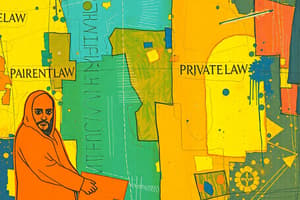Podcast
Questions and Answers
Sobre as fontes do Direito, é correto afirmar que:
Sobre as fontes do Direito, é correto afirmar que:
- Referem-se apenas às leis criadas pelos Parlamentos nacionais.
- Variam conforme os contextos sociais e históricos. (correct)
- São uniformes entre os países ocidentais desde a Revolução Francesa.
- São exclusivamente elaboradas pelo Estado, sem exceções.
Em relação ao sistema Civil Law, podemos dizer que:
Em relação ao sistema Civil Law, podemos dizer que:
- Está baseado exclusivamente em precedentes judiciais.
- Ele prioriza a jurisprudência em detrimento da legislação.
- Valoriza o processo legislativo como principal fonte do Direito. (correct)
- Surgiu com o direito consuetudinário dos povos anglo-saxões.
No contexto do Common Law:
No contexto do Common Law:
- As decisões judiciais são irrelevantes na formação do Direito.
- O Direito é codificado e interpretado por tribunais superiores.
- A jurisprudência e os costumes têm papel fundamental. (correct)
- O Parlamento é a única fonte legítima do Direito.
Sobre as fontes formais e materiais do Direito, é correto afirmar que:
Sobre as fontes formais e materiais do Direito, é correto afirmar que:
Qual das alternativas corresponde a um exemplo de costume contra legem?
Qual das alternativas corresponde a um exemplo de costume contra legem?
Assinale a alternativa que representa um Princípio Geral do Direito (PGD):
Assinale a alternativa que representa um Princípio Geral do Direito (PGD):
A analogia pode ser utilizada no Direito quando:
A analogia pode ser utilizada no Direito quando:
A vedação ao Non liquet implica que:
A vedação ao Non liquet implica que:
O que diferencia a analogia da interpretação extensiva?
O que diferencia a analogia da interpretação extensiva?
O que caracteriza uma fonte formal autônoma?
O que caracteriza uma fonte formal autônoma?
O direito consuetudinário (costumeiro) se caracteriza por:
O direito consuetudinário (costumeiro) se caracteriza por:
Em caso de omissão legislativa, o juiz deve:
Em caso de omissão legislativa, o juiz deve:
Qual das alternativas é um exemplo de fonte material do Direito?
Qual das alternativas é um exemplo de fonte material do Direito?
Sobre o princípio neminem laedere, é correto dizer que:
Sobre o princípio neminem laedere, é correto dizer que:
Quando a jurisprudência é considerada uma fonte do Direito?
Quando a jurisprudência é considerada uma fonte do Direito?
Qual das opções não é um Princípio Geral do Direito listado no material?
Qual das opções não é um Princípio Geral do Direito listado no material?
Flashcards
Sources of Law
Sources of Law
They vary according to social and historical contexts.
Civil Law System
Civil Law System
The legislature is valued as the main source of law.
Common Law Context
Common Law Context
Jurisprudence and customs play a fundamental role.
Formal vs. Material Sources
Formal vs. Material Sources
Signup and view all the flashcards
Custom contra legem example
Custom contra legem example
Signup and view all the flashcards
General Law Principle (PGD)
General Law Principle (PGD)
Signup and view all the flashcards
Analogy in Law
Analogy in Law
Signup and view all the flashcards
The prohibition to 'Non liquet'
The prohibition to 'Non liquet'
Signup and view all the flashcards
Analogy vs. extensive interpretation
Analogy vs. extensive interpretation
Signup and view all the flashcards
Customary law characteristics
Customary law characteristics
Signup and view all the flashcards
Legislative omission, judge's role
Legislative omission, judge's role
Signup and view all the flashcards
Example of material source of Law
Example of material source of Law
Signup and view all the flashcards
Principle 'neminem laedere'
Principle 'neminem laedere'
Signup and view all the flashcards
Jurisprudence as a source of Law
Jurisprudence as a source of Law
Signup and view all the flashcards
Not a General Law Principle
Not a General Law Principle
Signup and view all the flashcards
Study Notes
- Sources of Law vary according to social and historical contexts.
- Civil Law emphasizes legislative process as the main source of Law.
- In Common Law, jurisprudence and customs play a key role.
- Formal sources include legislation, jurisprudence, and custom.
- "Custom contra legem" consists of social practices against legal provisions.
- Nobody must do the impossible in law terms.
- Analogy can be used in Law when there is a legislative gap and the case is similar to one already regulated.
- In case of legislative omission, a judge should use analogy, customs and General Principles of Law (PGDs).
- There is a clear difference between analogy and extensive interpretation.
- Analogy applies a rule from a similar case; extensive interpretation broadens the meaning of an existing rule.
- An explicit source is the one elaborated by the interested parties without state intervention.
- Customary law results from constant, spontaneous and unwritten practices in society.
- Judges must use analogy, customs and general principles of law.
- Material source examples are the social facts considered when creating new laws.
- The principle "nmenim laedere" expresses the duty not to harm others.
- Jurisprudence becomes a source of law when consistently consolidated jurisprudence from the courts.
- "Pacta sunt servanda" is not a General Principle of Law (PGD).
Studying That Suits You
Use AI to generate personalized quizzes and flashcards to suit your learning preferences.



